Development of a Mobile Application to Buy Books through Visual Recognition
Abstract
:1. Introduction
2. Materials and Methods
- Provide a simple search engine for books based on title and author.
- Offer a search engine that takes the image of the book cover as input.
- Show a list with the possible results to choose the exact book that the user refers to see relevant information about the book at a glance, such as a title, author, description, publication date, publisher, number of pages, or its ISBN.
- Offer the possibility of reading a preview or the entire book online.
- Download the book in digital format.
- See book purchase links from the most common sellers.
- Have a favorites section.
- Server-centric administration: the client has minimal administration needs.
- Centralization of the resources: the resources of all the users are in a single server, thus avoiding the inconsistency and redundancy of the databases.
- Improved security: the chances of improper access are reduced, as there is a centralized authentication mechanism.
- Scalability of the installation: the network and its operation are not affected by the incorporation or elimination of users.
3. Results
3.1. Login and Registration
3.2. Search by Image
3.3. Manual Search
3.4. Querying a Book
3.5. Favorites
3.6. Historical Information
4. Conclusions
Funding
Institutional Review Board Statement
Informed Consent Statement
Data Availability Statement
Acknowledgments
Conflicts of Interest
References
- Uğur, N.G.; Turan, A.H. Mobile Applications Acceptance: A Theoretical Model Proposal and Empirical Test. Int. J. E-Adopt. 2019, 11, 13–30. [Google Scholar]
- Henze, N.; Pielot, M.; Poppinga, B.; Schinke, T.; Boll, S. My app is an experiment: Experience from user studies in mobile app stores. Int. J. Mob. Hum. Comput. Interact. 2011, 3, 71–91. [Google Scholar]
- Adrakatti, A.F.; Mulla, K.R. A realistic approach to information services on mobile apps. J. Access Serv. 2017, 14, 7–15. [Google Scholar]
- Shim, K.; Yim, J. Design and implementation of a mobile shopping app specializing in regional product. Int. J. Multimed. Ubiquitous Eng. 2016, 11, 43–54. [Google Scholar]
- Megalingam, R.K.; Vishnu, S.; Sekhar, S.; Sasikumar, V.; Sreekumar, S.; Nair, T.R. Design and implementation of an android application for smart shopping. In Proceedings of the 2019 International Conference on Communication and Signal Processing (ICCSP), Melmaruvathur, India, 4–6 April 2019; pp. 0470–0474. [Google Scholar]
- Silva, M.; Morais, D.; Mazeda, M.; Teixeira, L. Mobile Applications in Cultural Heritage Context: A Survey. In Multidisciplinary Perspectives on New Media Art; IGI Global: Hershey, PA, USA, 2020; pp. 189–216. [Google Scholar]
- Mansouri, A.; Asl, N.S. Assessing mobile application components in providing library services. Electron. Libr. 2019, 37, 49–66. [Google Scholar]
- McCarthy, G.; Wilson, S. ISBN and QR barcode scanning mobile app for libraries. Code4Lib J. 2011, 13. [Google Scholar]
- Mu, Z.; Jiang, L. Online Bookstore Management System Based on Android. In Proceedings of the 2018 International Conference on Virtual Reality and Intelligent Systems (ICVRIS), Changsha, China, 10–11 August 2018; pp. 498–500. [Google Scholar]
- Dinesh, R.; Pravin, S.A.; Aravindhan, M.; Rajeswari, D. Library access system smartphone application using android. Int. J. Comput. Sci. Mob. Comput. 2015, 4, 142–149. [Google Scholar]
- Roy, M.B.; Kumar, N. Application of mobile technology in Library services. Int. J. Inf. Mov. 2017, 2, 168–172. [Google Scholar]
- Chen, Y.; Sun, Y.; Zhang, F. A Crowd-Sourcing Mobile Platform for Textbook Selling and Exchange Using Information Retrieval. In Proceedings of the 2019 Conference CS & IT Conference; AIRCC Publishing Corporation: Tamil Nadu, India, 2019. [Google Scholar]
- Reis, A.; Paulino, D.; Filipe, V.; Barroso, J. Using online artificial vision services to assist the blind-an assessment of microsoft cognitive services and google cloud vision. In Trends and Advances in Information Systems and Technologies; Springer: Berlin/Heidelberg, Germany, 2018; pp. 174–184. [Google Scholar]
- Mishra, A. Machine Learning in the AWS Cloud: Add Intelligence to Applications with Amazon SageMaker and Amazon Rekognition; John Wiley & Sons: Hoboken, NJ, USA, 2019. [Google Scholar]
- Agbemenu, A.S.; Yankey, J.; Addo, E.O. An automatic number plate recognition system using opencv and tesseract ocr engine. Int. J. Comput. Appl. 2018, 180, 1–5. [Google Scholar]
- Graziani, D.; Soriano, J.B.; Rio-Bermudez, D.; Morena, D.; Díaz, T.; Castillo, M.; Izquierdo, J.L. Characteristics and Prognosis of COVID-19 in Patients with COPD. J. Clin. Med. 2020, 9, 3259. [Google Scholar]
- Spreafico, C.; Spreafico, M. Using text mining to retrieve information about circular economy. Comput. Ind. 2021, 132, 103525. [Google Scholar]
- Marfianto, A.; Riadi, I. WhatsApp messenger forensic analysis based on Android using text mining method. Int. J. Cyber Secur. Digit. Forensics 2018, 7, 319–327. [Google Scholar]
- Malaperdas, G. Digitization in Archival Material Conservation Processes. Eur. J. Eng. Technol. Res. 2021, 6, 30–32. [Google Scholar]
- Broos, S.; Marcos Ramos, J. Google, Google Shopping and Amazon: The Importance of Competing Business Models and Two-Sided Intermediaries in Defining Relevant Markets. Antitrust Bull. 2017, 62, 1–18. [Google Scholar]
- Chopdar, P.K.; Korfiatis, N.; Sivakumar, V.J.; Lytras, M.D. Mobile shopping apps adoption and perceived risks: A cross-country perspective utilizing the Unified Theory of Acceptance and Use of Technology. Comput. Hum. Behav. 2018, 86, 109–128. [Google Scholar]
- Zaim, H.; Ramdani, M.; Haddi, A. Fuzzy-based mining framework of browsing behavior to enhance E-commerce website performance: Case study from Kelkoo. com. In Proceedings of the 12th International Conference on Intelligent Systems: Theories and Applications, Rabat, Morocco, 9–10 May 2018; pp. 1–6. [Google Scholar]
- McLean, G.; Wilson, A. Shopping in the digital world: Examining customer engagement through augmented reality mobile applications. Comput. Hum. Behav. 2019, 101, 210–224. [Google Scholar]
- Hermes, D. Xamarin Mobile Application Development: Cross-Platform c# and Xamarin. Forms Fundamentals; Apress: New York, NY, USA, 2015. [Google Scholar]
- Wankhede, P.; Talati, M.; Chinchamalatpure, R. Comparative study of cloud platforms-Microsoft Azure, Google Cloud Platform and Amazon EC2. J. Res. Eng. Appl. Sci. 2020, 5, 60–64. [Google Scholar]
- Gojare, S.; Joshi, R.; Gaigaware, D. Analysis and design of selenium webdriver automation testing framework. Procedia Comput. Sci. 2015, 50, 341–346. [Google Scholar]
- Costello, E.; Bolger, R.; Soverino, T.; Brown, M. Determining textbook cost, formats, and licensing with Google books API: A case study from an open textbook project. Inf. Technol. Libr. 2019, 38, 91–99. [Google Scholar]
- Spreafico, C.; Russo, D.; Spreafico, M. Investigating the evolution of pyrolysis technologies through bibliometric analysis of patents and papers. J. Anal. Appl. Pyrolysis 2021, 159, 105021. [Google Scholar]
- Botchkarev, A. Performance Metrics (Error Measures) in Machine Learning Regression, Forecasting and Prognostics: Properties and Typology. arXiv 2019, arXiv:1809.03006. [Google Scholar]
- Naser, M.Z.; Alavi, A.H. Error Metrics and Performance Fitness Indicators for Artificial Intelligence and Machine Learning in Engineering and Sciences. Archit. Struct. Constr. 2021, 2020, 1–19. [Google Scholar] [CrossRef]
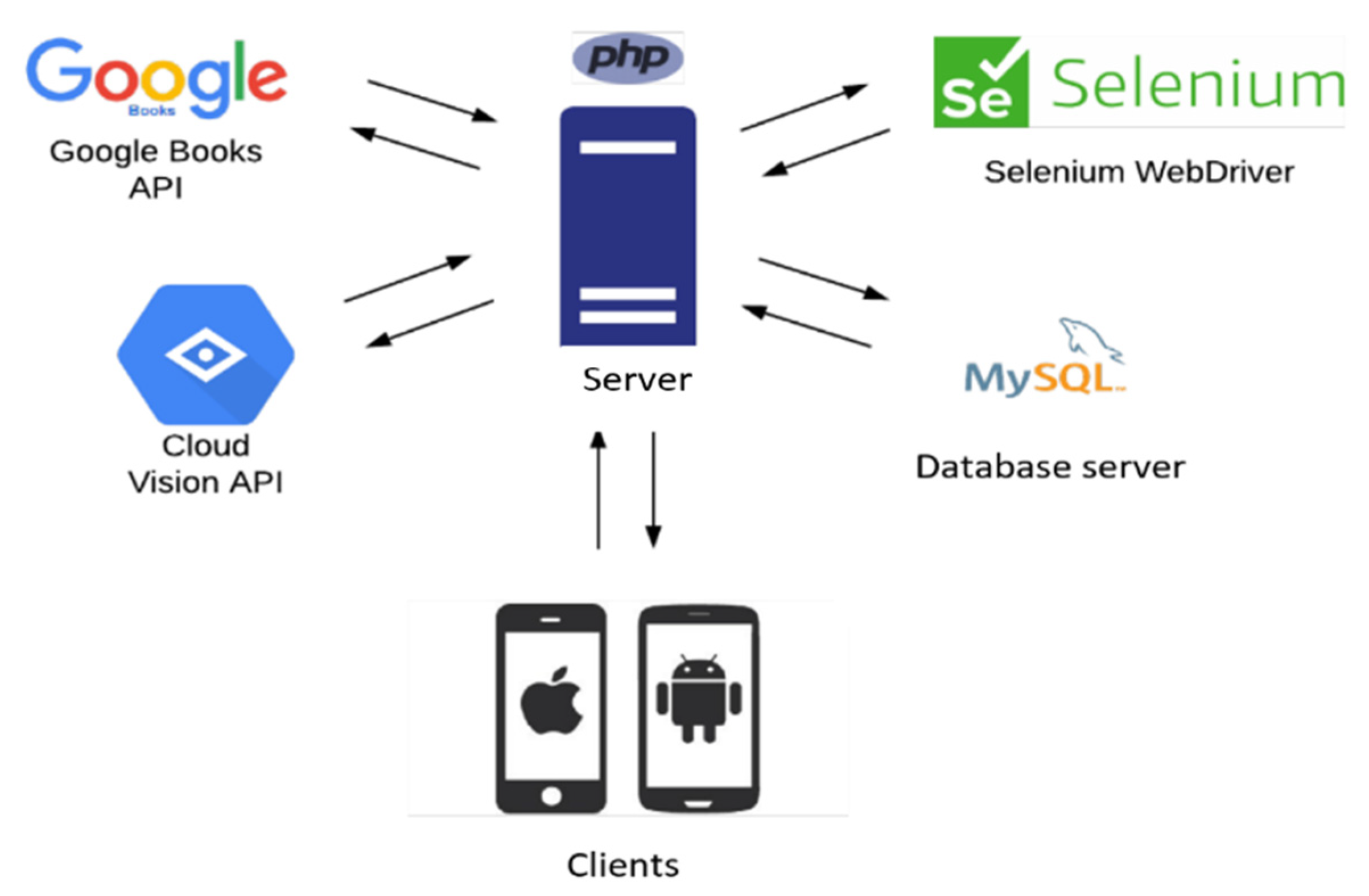



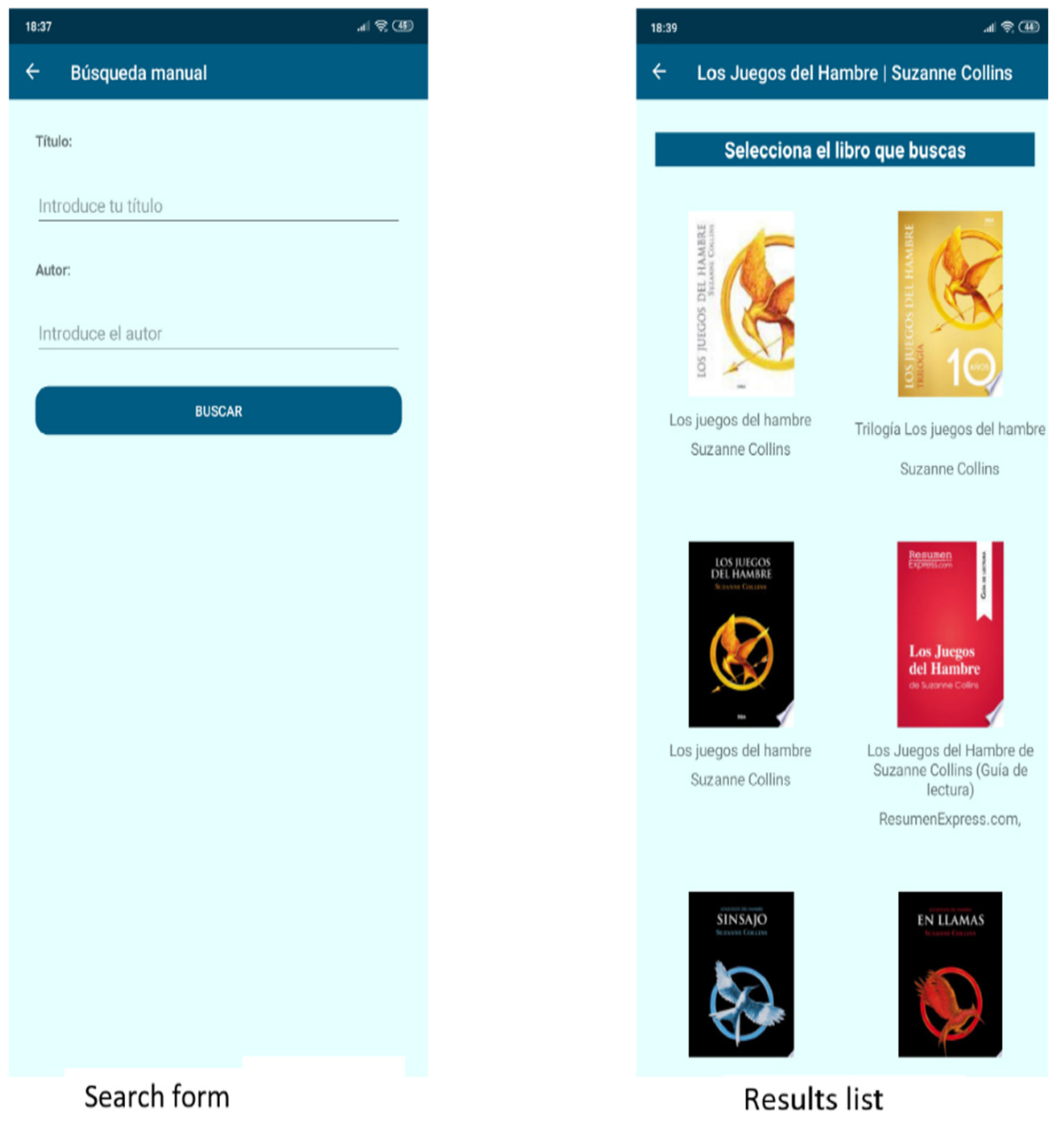
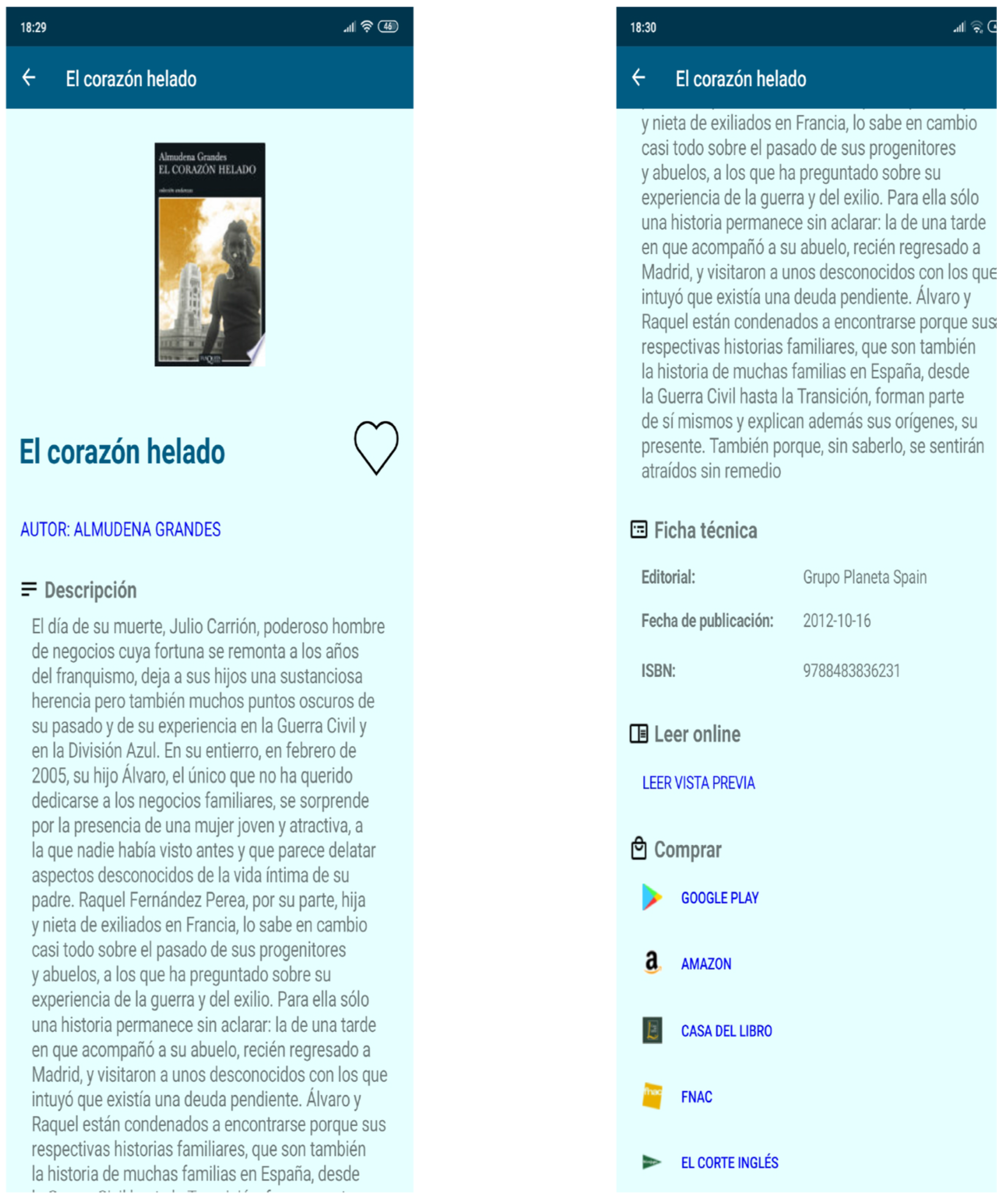
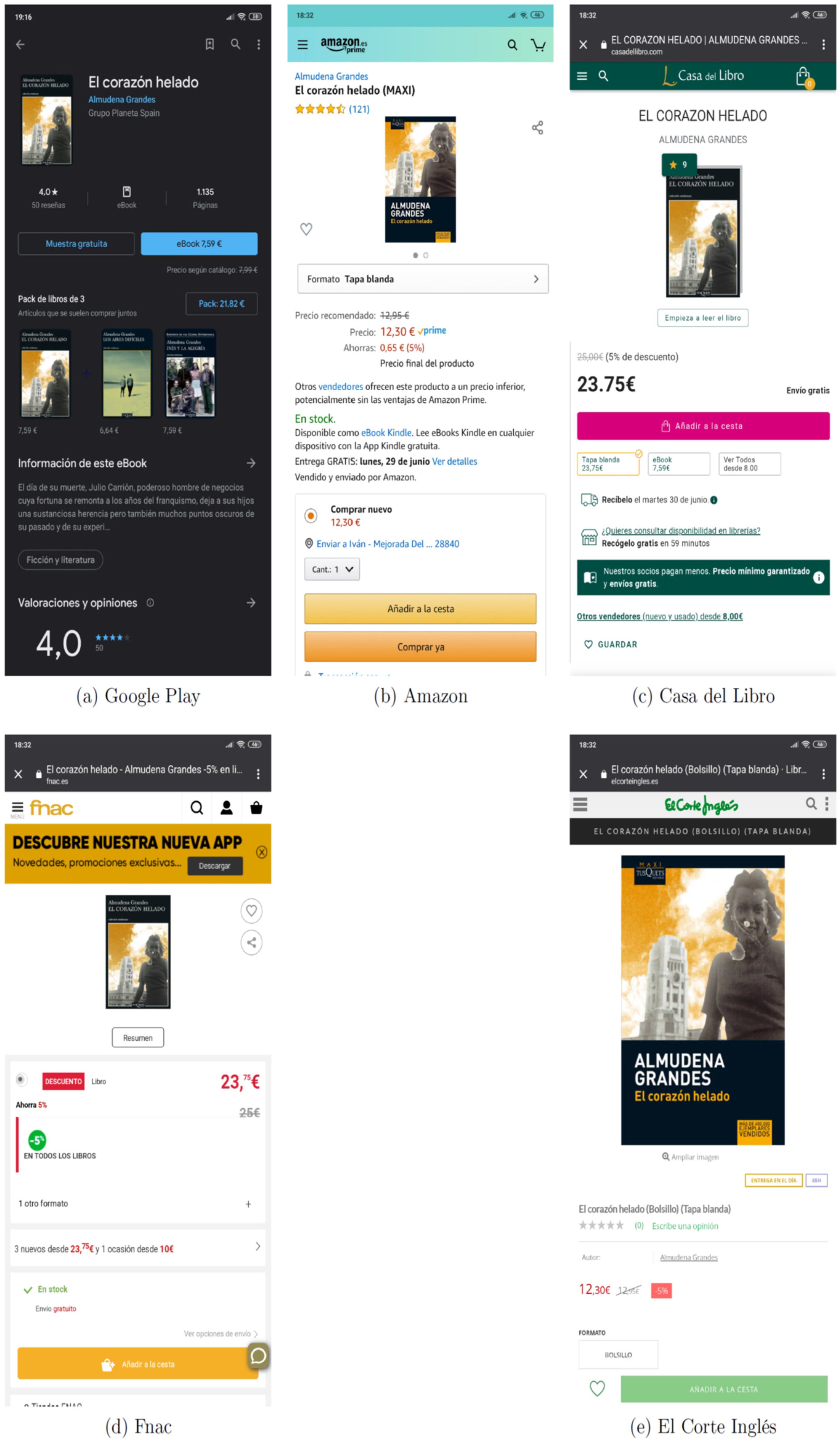

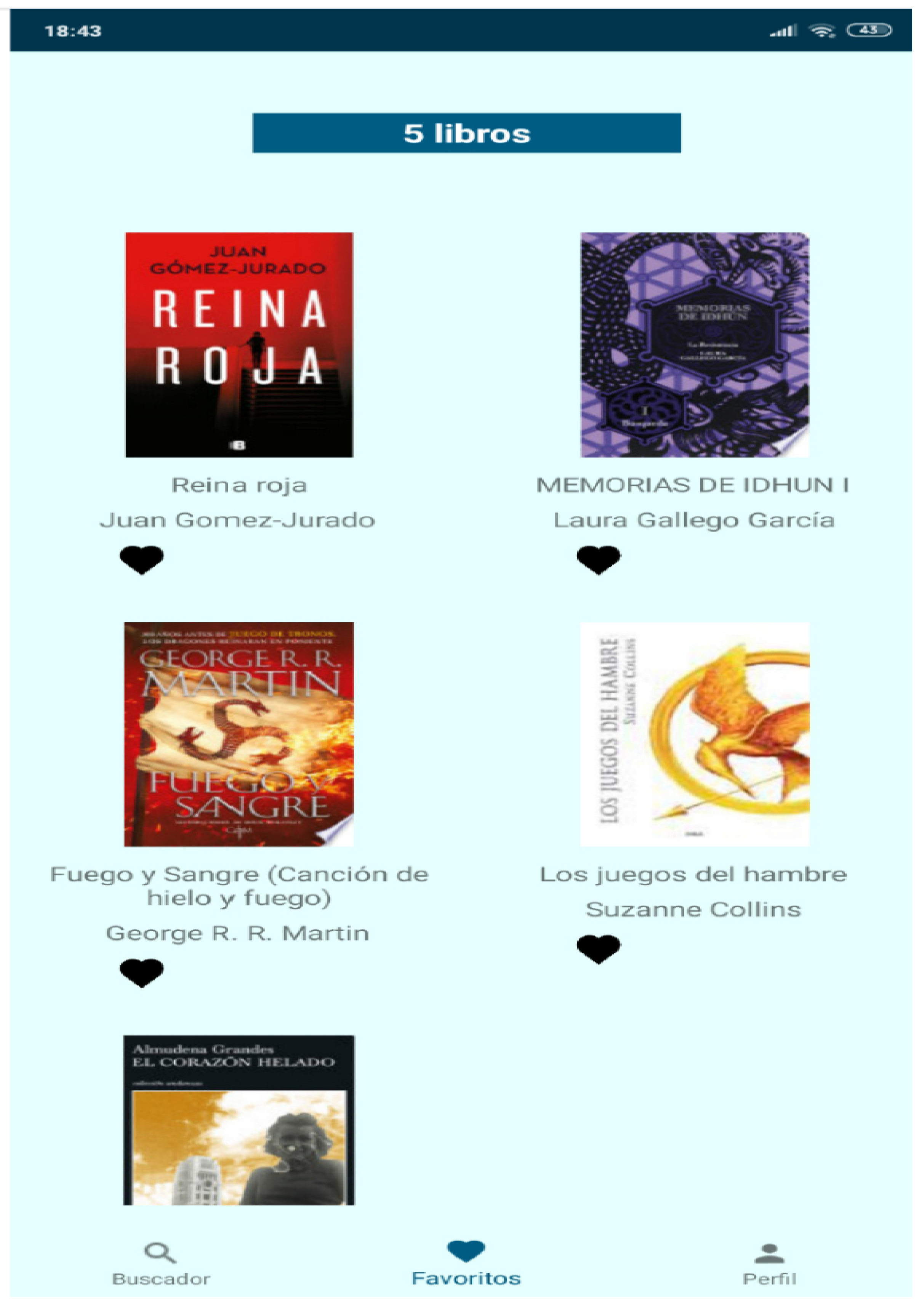

Publisher’s Note: MDPI stays neutral with regard to jurisdictional claims in published maps and institutional affiliations. |
© 2022 by the author. Licensee MDPI, Basel, Switzerland. This article is an open access article distributed under the terms and conditions of the Creative Commons Attribution (CC BY) license (https://creativecommons.org/licenses/by/4.0/).
Share and Cite
Sarasa-Cabezuelo, A. Development of a Mobile Application to Buy Books through Visual Recognition. Knowledge 2022, 2, 41-54. https://doi.org/10.3390/knowledge2010003
Sarasa-Cabezuelo A. Development of a Mobile Application to Buy Books through Visual Recognition. Knowledge. 2022; 2(1):41-54. https://doi.org/10.3390/knowledge2010003
Chicago/Turabian StyleSarasa-Cabezuelo, Antonio. 2022. "Development of a Mobile Application to Buy Books through Visual Recognition" Knowledge 2, no. 1: 41-54. https://doi.org/10.3390/knowledge2010003
APA StyleSarasa-Cabezuelo, A. (2022). Development of a Mobile Application to Buy Books through Visual Recognition. Knowledge, 2(1), 41-54. https://doi.org/10.3390/knowledge2010003





